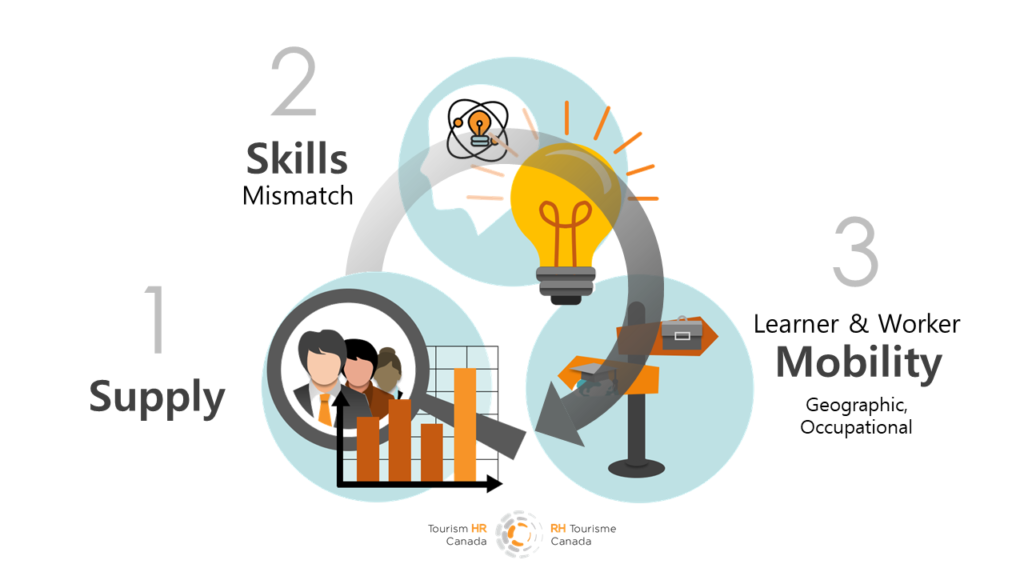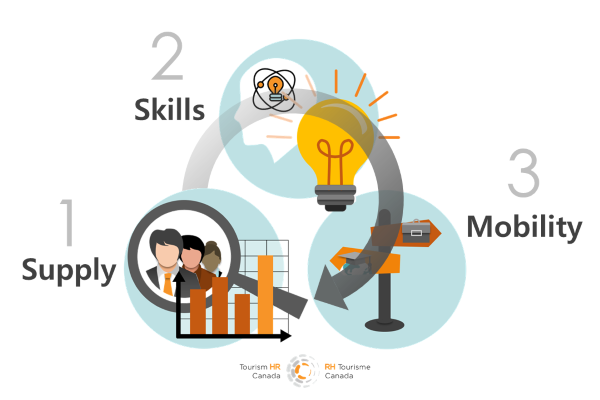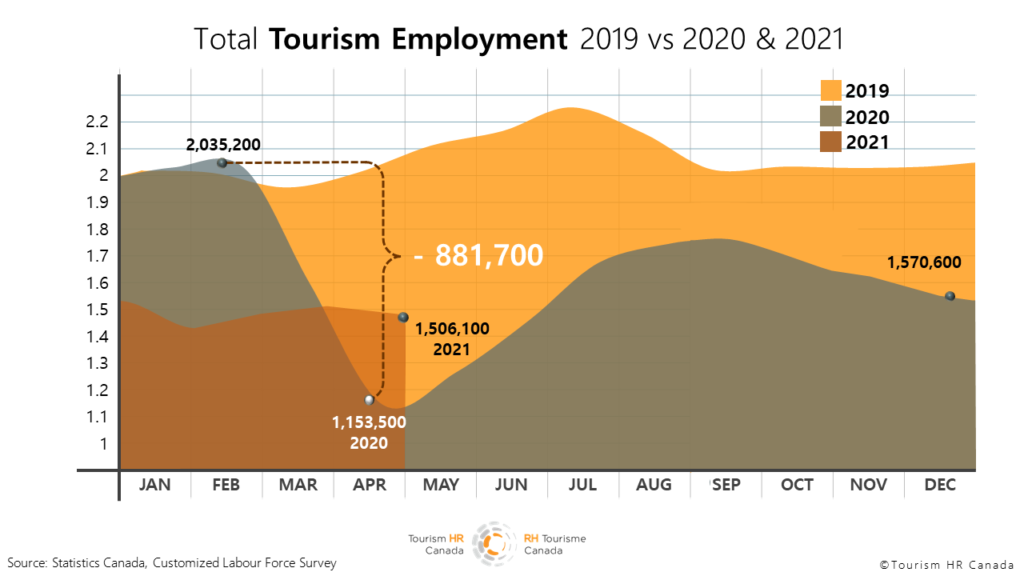Workforce in Disarray
COVID-19 has caused significant disruption to the tourism labour market, much greater than the economy overall. Many workers are not going to return to jobs once they are restored, causing some of the greatest labour shortages ever seen and hampering recovery. The reasons for this are complex and solutions or ways to address the chronic shortfall require multiple strategies.
Where does one begin and what should the focus be?
Most workforce issues are attributed to three dimensions:
- The supply of workers: Do we have enough or too many workers?
- The alignment (or misalignment) of skills, i.e. the ‘skills mismatch’: Do the workers have the right skills for the job?
- Geographic and occupational mobility: Are learners and workers located in regions where they are needed?

Each of these dimensions helps diagnose and illustrate the tourism workforce challenges, most of which have been heightened or accelerated because of COVID-19.
Chronic Short Supply of Workers Hampers Recovery and Growth
The tourism sector was experiencing severe shortages of workers prior to COVID. As the sector recovers, the anticipated shortages will more acute and the difficulty to attract and retain workers is expected to be more difficult. Although there is currently a high level of unemployment, the longer the outlook for reopening, the more the sector is losing its workforce to other industries. Other factors such as the precarity of employment (e.g., uncertainty around job stability, worries about too few hours or suppressed wages), concerns about safety, changing job demands, inadequate childcare supports, and various other factors are creating the perfect storm. (You may also be interested in the Workforce Power Session webinar or Lost Momentum: Newly Released Data Shows the Rapid Tourism Job Growth COVID Interrupted.)
As stated in the Workforce Shortfall Report, a critical shortage of skilled labour hampers growth and recovery and contributes to higher operating costs and reduced profits. Without workers, businesses forego investments, lose their ability to compete, burn out staff, and ultimately anger and turn off customers. (This is clearly not the image we want for Canadian tourism.)
Skills for Sustained Economic Relaunch and Global Competitiveness
COVID-19 has significantly impacted the nature of tourism jobs and created an unparalleled shift in skill sets needed. Recovery, resiliency, and sustained competitiveness require new skills and lifelong learning, including a focus on digital transitions. All tourism workers (frontline, supervisory/operational, management) require the right skills to enable the sector to have a sustained economic relaunch and be globally competitive.
Training in many forms is needed to make sure people can acquire the skills they need for current and future job demands. Support for the development of new skills training content and new delivery modes, including addressing sub-sector and regional differences, is needed. Tourism HR Canada has previously reported that the tourism sector is going to rely heavily on accessible virtual learning that enables job seekers and workers to obtain micro-credentials and tailored learning products (i.e., just-in-time, cost-effective learning responsive to market and employer demands). One example of a program recently updated and relaunched in response to COVID is the Business Builders Series for operators and entrepreneurs. (Limited time offer: this program is available at no cost for anyone that signs up now.)
To get a glimpse at some emerging skills, check out Impact of Digitalization on Tourism Jobs.
Learner and Worker Mobility
Labour mobility is all about the ability of workers and learners to move around or relocate for employment. Mobility usually refers to both geographic and occupational concerns. Geographic mobility refers to the worker’s ability to relocate or change work location, while occupational mobility refers to changing of jobs. Learner mobility is most often associated with the rights to transfer credits or acquired learning to new educational pursuits.
Factors inhibiting mobility are often linked to outdated policies or resource constraints. Prohibitive costs associated with relocation, a lack of affordable housing, inadequate infrastructure, or institutional policies that prohibit mobility are all examples that prevent people from accessing employment opportunities.
Program and Policy Focus
Budget 2021 contains a lot of promising funding initiatives that have the potential to help address tourism workforce recovery efforts. The sector’s current focus is extended advocacy to help secure projects and funding for tourism workforce initiatives, anticipating the ability to tap into various new programs:
- Canada Recovery Hiring Program
- Skills for Success
- Community Workforce Development Program
- Sectoral Workforce Solutions Program
- Canada Digital Adoption Plan
In addition, the sector may benefit from programs that have been extended or renewed. These include:
- Student Work Placement Program
- Helping Youth and Students Build Job Skills and Connect with Employers
- Youth Employment and Skills Strategy
- Canada Summer Jobs
- Enhancing the Canada Workers Benefit
Other measures will contribute significantly to helping build the tourism workforce and meeting the needs of vulnerable and precarious workers in the sector. The Canada-Wide Early Learning and Child Care System, the National Mental Health Standards, and supports for businesses to pay for mandatory quarantine for Temporary Foreign Workers will be a great help to the sector.
What Employers Can Do Now
Checklist of Ten Practical HR Practices to Attract and Retain Workers
- Diversify recruitment strategy: go after new markets and ones that are best fit for the sector, e.g., New Canadians, Indigenous Peoples.
- Invest in professional development and value career progression: help workers grow professionally and personally; mentor and coach.
- Accommodate workers’ needs and personal work-life balance interests, e.g., flexible scheduling, providing workplace aids and tools.
- Enable increased flexibility in work duties: design the jobs to match workers’ interests.
- Prioritize safety and security, e.g., ensure there is sufficient and appropriate personal protective equipment (where applicable); provide taxi rides for safe transport late at night.
- Offer competitive compensation.
- Create a welcoming and inclusive workplace, e.g., enable employees to have input, share suggestions and ideas; be explicit on zero tolerance for anti-oppressive behaviours; communicate honestly and with fairness.
- Provide recognition and consistent feedback.
- Invest in HR practices: make human capital a business priority by ensuring managers have the skills and knowledge to motivate and manage productive teams.
- Be clear about company vision, corporate goals, and mission: establish a brand and reputation that is attractive and distinct to your competitors.
A few other important strategies that will help you build a competitive, inclusive, and resilient workforce:
- Support the advocacy efforts of professional associations (e.g., Tourism Industry Association of Canada, Indigenous Tourism Association of Canada, Hotel Association of Canada), who are working on your behalf to align policies and programs that address workforce issues.
- Let your MP know the challenges you are facing and the need for sector-specific programs and policies that address workforce needs.
- Lead or be involved in community-led workforce planning. Tourism’s future workforce relies on community-led models (it’s beyond enterprises and must involve collaboration between employers, governments, workers, education providers, and various support services).


